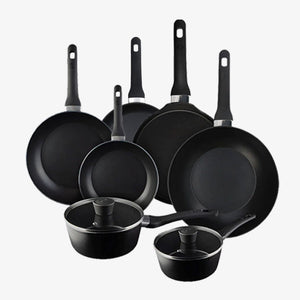Seven Easy Steps to Clean a Non-Stick Pan
• Firstly, allow the pan to cool before washing as hot liquids can damage the protective layer of non-stick pans.
• Then, gently wipe the surface of the pan with a soft sponge or cloth until any residue is removed and the inside is clean.
• For more stubborn stains, use a non-abrasive sponge or stiff-bristled brush with hot water to gently scrub them clean. Do not use steel wool or any other abrasive material that can scratch the surface.
• Rinse your pans thoroughly with hot water to remove any remaining soap or cleaning solution.
• Once clean, use a soft cloth or paper towels to dry them thoroughly, making sure to dry the inside and outside of the pan as well as any handles or edges.
• Store your pans in a dry, cool place. To avoid scratching or damaging the surface, stack them
with a layer of paper towels or felt pads between each pan.
• Don't forget to also use non-metal utensils as they can scratch the surface. Use silicone, wooden or plastic instead.



